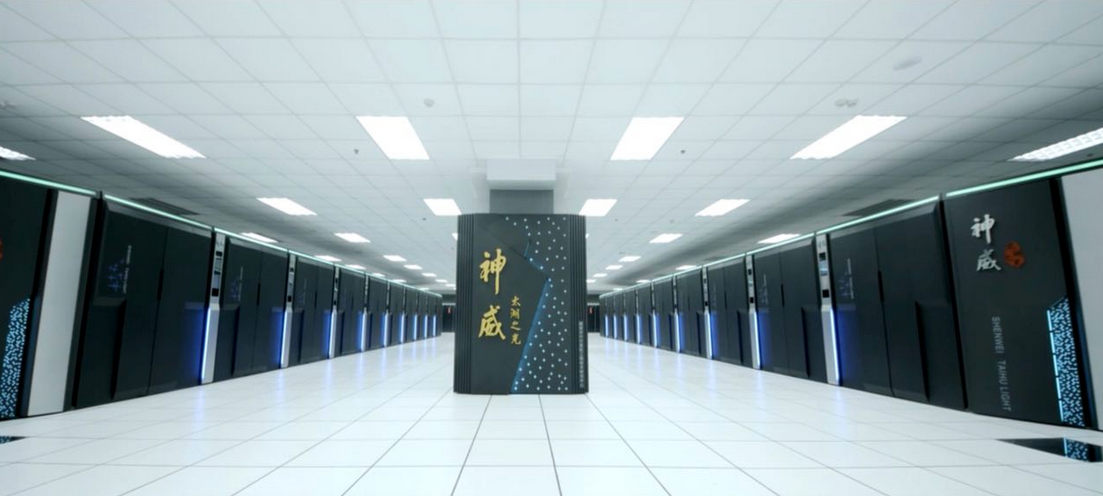China’s Sunway TaihuLight tops world supercomputer ratings
June 20, 2016

Sunway TaihuLight System (credit: National Supercomputing Center)
Chinese supercomputers maintained their No. 1 ranking on the 47th edition of the TOP500 list of the world’s top supercomputers, announced today (June 20). The new Sunway TaihuLight supercomputer operates at 93 petaflop/s (quadrillions of calculations per second) Rmax on the LINPACK benchmark — twice as fast and three times as efficient as China’s Tianhe-2 (at 33.86 petaflop/s), now in the #2 spot.
The new supercomputer was developed by the National Research Center of Parallel Computer Engineering & Technology (NRCPC) and installed at the National Supercomputing Center in Wuxi in China’s Jiangsu province. The complete system has a theoretical peak performance of 125.4 Pflop/s, with 10,649,600 cores and 1.31 PB of primary memory, according to a report by Top500 co-compiler Jack Dongarra of the University of Tennessee.
The newest edition of the semiannual TOP500 list was announced today at the 2016 International Supercomputer Conference in Frankfurt.
China now leads with largest number of supercomputers
The latest list marks the first time since the inception of the TOP500 that the U.S is not home to the largest number of systems. China now leads with 167 systems and the U.S. is second with 165. China also leads the performance category, thanks to the No. 1 and No. 2 systems. Titan, a Cray XK7 system installed at the Department of Energy’s (DOE) Oak Ridge National Laboratory, is now the No. 3 system, at 17.59 petaflop/s.
Sunway TaihuLight was also built entirely using processors designed and made in China (Tianhe-2 was built with Intel processors).
U.S. primacy on the Top500 list has slipped for a number of reasons, including lower government support, private-sector investing now focused on cloud-computing centers, and the U.S. policy of blocking the sale of a number of advanced microprocessors to China, possibly accelerating development of China’s own technology, the New York Times reports. (Last year, the Obama administration began a new effort to develop an“exascale” supercomputer; it would be more than 10 times faster than the Sunway TaihuLight.)
However, because of funding shortages and technology challenges, “there has been a delay in getting the exascale launched in the U.S., and as a result, we’re further behind than we should be,” Dongarra told the Times, noting that the Chinese government is committed to reaching the exascale goal by the end of this decade.
Cray continues to be the leader in the TOP500 list in total installed performance share, with 19.9 percent (down from 25 percent). Thanks to the Sunway TaihuLight system, the National Research Center of Parallel Computer Engineering & Technology takes the second spot with 16.4 percent of the total performance — with just one machine. IBM takes the third spot with 10.7 percent share, down from 14.9 percent six months ago.
Energy-efficiency ratings
For the first time, the data collection and curation of the Green500 project, which ranks supercomputers by energy efficiency, is now integrated with the TOP500 project. The most energy-efficient system and No. 1 on the Green500 is Shoubu, a PEZY Computing/Exascaler ZettaScaler-1.6 System achieving 6.67 GFfops/Watt at the Advanced Center for Computing and Communication at RIKEN in Japan.
Other highlights from the Top 500 list:
- Total combined performance of all 500 systems has grown to 566.7 petaflop/s, compared to 420 petaflop/s six months ago and 363 petaflop/s one year ago.
- There are 95 systems with performance greater than a petaflop/s on the list, up from 81 six months ago.
- Intel continues to provide the processors for the largest share – 455 systems or 91 percent – of the TOP500 systems. The share of IBM Power processors is now at 23 systems, down from 26 systems six month ago. The AMD Opteron family is used in 13 systems (2.6 percent), down from 4.2 percent on the previous list.